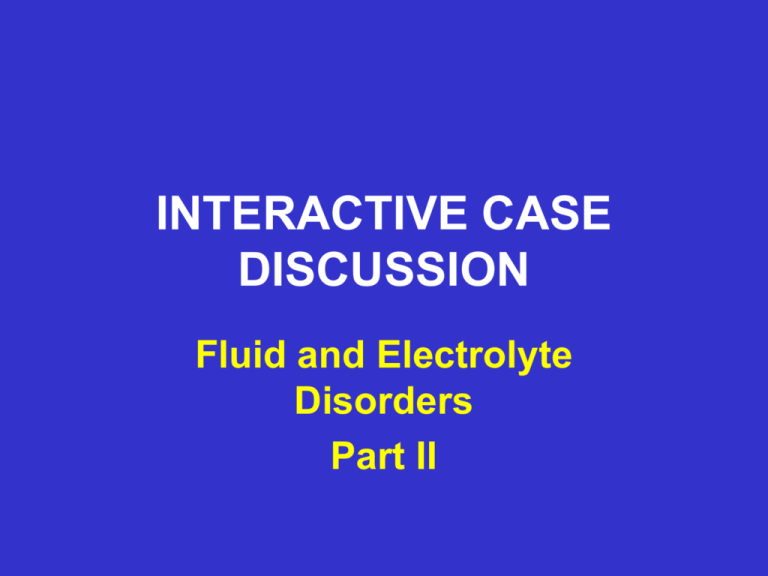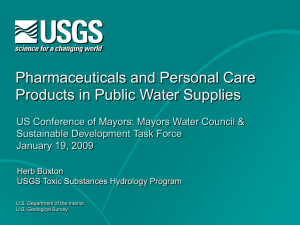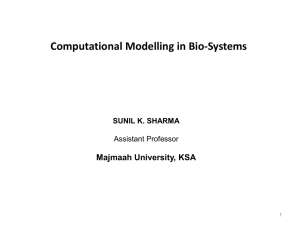Fluid & electrolyte Disorders Part 3
advertisement

INTERACTIVE CASE DISCUSSION Fluid and Electrolyte Disorders Part II Fluid and Electrolytes Part II CASE # 1: • 60 y/o male with ischemic cardiomyopathy and CHF. Admitted because of orthopnea. • 150/60, HR=120/min, RR = 38/min • JVP = 20 (); bibasal inspiratory crackles • S3 gallop; ascites; pedal edema • Na = 125meq/L () • Posm = 270 mosm/kg () • Uosm = 500 mosm/kg Fluid and Electrolytes Part II Question # 1: Describe the patient’s fluid and electrolyte status. A. Na deficit, water deficit B. Na deficit, water excess C. Na excess, water deficit D. Na excess,water excess Fluid and Electrolytes Part II Answer #1: Na excess, water excess • Hyponatremic (Na=125) hence he has water excess. • Hypervolemia on physical examination ( BP, JVP,crackles, ascites, edema ) hence he has Na excess. Fluid and Electrolytes Part II REMEMBER ! Serum Na Na balance Serum Na = Water balance Volume status = Na balance Fluid and Electrolytes Part II Question # 2: How will you approach the problem of hyponatremia? HYPONATREMIA Plasma Osmolality (285-295) High •Hyperglycemia •Mannitol Normal •Hyperproteinemia •Hyperlipidemia •Bladder irrigaton Low True Hyponatremia Maximally Dilute urine Singer, 2001 HYPONATREMIA Maximally dilute urine Uosm < 100 No ECF Volume Yes Primary polydipsia Reset osmostat Singer, 2001 HYPONATREMIA ECF Volume Increased CHF Cirrhosis Renal failure Nephrosis Normal Hypothyroid Hypoadrenal SIADH Decreased Urine Na Singer, 2001 HYPONATREMIA Urine Na UNa < 10 meq/L UNa > 20 meq/L Extrarenal Na loss Remote diuretics Remote vomiting Na wasting nephropathy Hypoaldosteronism Diuretics Vomiting Singer, 2001 Fluid and Electrolytes Part II Question # 3: What is the most likely cause of hyponatremia in this patient? A. Congestive heart failure B. Diuretics C. Hypothyroidism D. Syndrome of Inappropriate ADH secretion (SIADH) Fluid and Electrolytes Part II Answer # 3: Congestive heart failure • Low Posm excludes pseudohypoNa. • Uosm > 100 (500) hence not primary polydipsia or reset osmostat • Volume status increased (Na excess) • Compatible with CHF Fluid and Electrolytes Part II CASE # 2: 30 y/o 70kg male suffered a skull fracture due to MVA. • 86/60,HR=110/min. • JVP = 4, poor skin turgor • Dry mucosa, no edema • Na = 168 meq/L • Posm = 350mosm/kg; Uosm = 80mosm/kg • 24 hr urine output = 4 liters Fluid and Electrolytes Part II Question # 4: Describe the patient’s fluid and electrolyte status. A. Na deficit, water deficit B. Na deficit, water excess C. Na excess, water deficit D. Na excess, water excess Fluid and Electrolytes Part II Answer # 4: Na deficit, water deficit • Hypernatremic ( Na = 168) hence he has water deficit. • Hypovolemic on physical examination ( BP, JVP,poor skin turgor, drymucosa) hence he has Na deficit. Fluid and Electrolytes Part II REMEMBER ! Serum Na Na balance Serum Na = Water balance Volume status = Na balance Fluid and Electrolytes Part II Question # 5: Calculate the amount of water deficit in this patient. Fluid and Electrolytes Part II Answer # 5: 7 liters Water deficit = Plasma Na – 140/140 X ( 0.5 X BW ) = 168 – 140/140 X ( 0.5 X 70 ) = 7 liters. Fluid and Electrolytes Part II Question # 6: How will you approach the problem of hypernatremia? HYPERNATREMIA ECF Volume Increased Administration of Hypertonic NaCl and NaHCO3 Not increased Minimum volume of maximally concentrated urine (Uosm) Singer, 2001 HYPERNATREMIA UOsm > 800 No Urine osmolar excretion rate Yes Insensible H2O loss GI H20 loss Remote renal H2O loss Singer, 2001 HYPERNATREMIA Urine osmolar excretion rate > 750 mosm/day No Renal response to desmopressin UOsm Central DI Yes Osmotic diuresis Diuretic Uosm no Nephrogenic DI Singer, 2001 Fluid and Electrolytes Part II Question # 7: What is the most likely cause of the patient’s hyperNa? A. Diabetes insipidus B. GI water losses C. IV hypertonic NaCl D. Osmotic diuresis Fluid and Electrolytes Part II Answer # 7: Diabetes insipidus • Not hypervolemic hence not IV hypertonic NaCl. • Uosm < 100 (dilute) hence not extrarenal water losses (GI losses). • Urine osmolar excretion rate = Uosm X U volume; 80mosm/kg x 4 liters/d = 320 mosm/d (< 750mosm/d); hence not osmotic diuresis. Fluid and Electrolytes Part II Question # 8: The patient was given a dose of desmopressin (ADH analog). The Uosm after the dose is 800 mosm/kg. What is the cause of the diabetes insipidus? A. Central diabetes insipidus B. Nephrogenic diabetes insipidus Fluid and Electrolytes Part II Answer # 8: Central DI • The Uosm increased after the desmopressin dose. The Uosm will not change even after repeated desmopressin doses in patients with nephrogenic DI.

